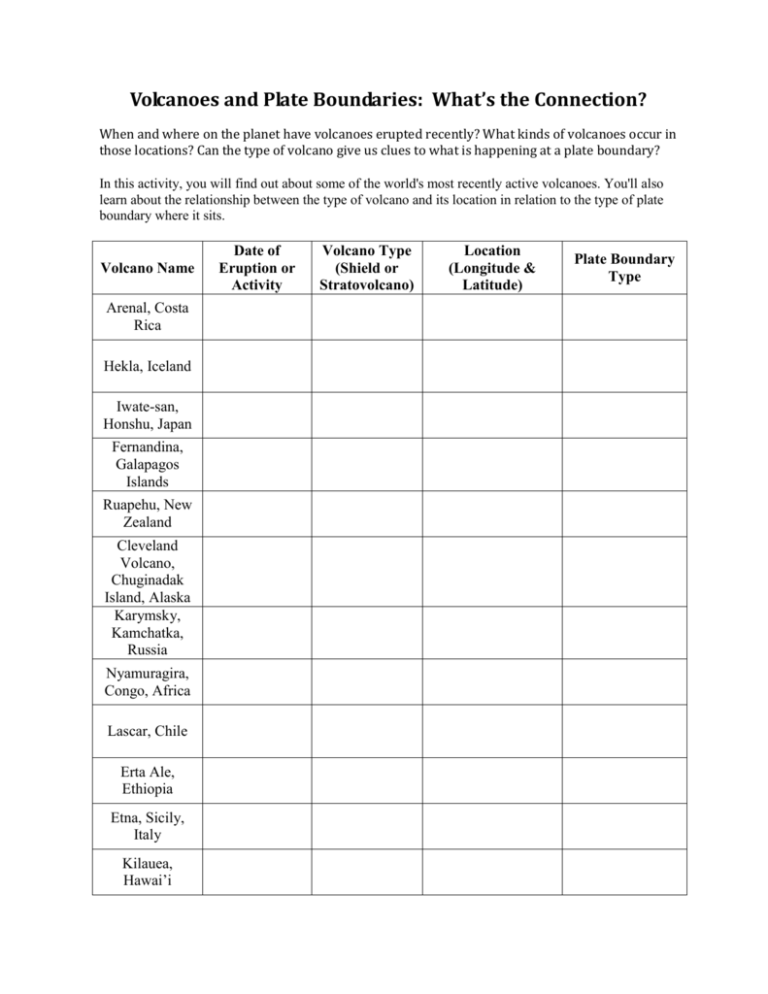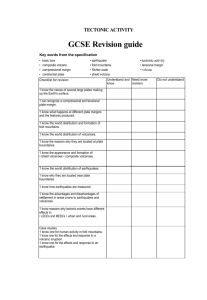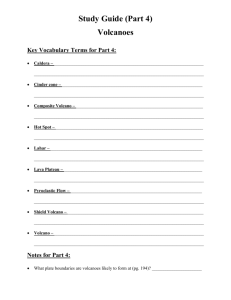Volcanoes and Plate Boundaries: What`s the Connection
advertisement

Volcanoes and Plate Boundaries: What’s the Connection? When and where on the planet have volcanoes erupted recently? What kinds of volcanoes occur in those locations? Can the type of volcano give us clues to what is happening at a plate boundary? In this activity, you will find out about some of the world's most recently active volcanoes. You'll also learn about the relationship between the type of volcano and its location in relation to the type of plate boundary where it sits. Volcano Name Arenal, Costa Rica Hekla, Iceland Iwate-san, Honshu, Japan Fernandina, Galapagos Islands Ruapehu, New Zealand Cleveland Volcano, Chuginadak Island, Alaska Karymsky, Kamchatka, Russia Nyamuragira, Congo, Africa Lascar, Chile Erta Ale, Ethiopia Etna, Sicily, Italy Kilauea, Hawai’i Date of Eruption or Activity Volcano Type (Shield or Stratovolcano) Location (Longitude & Latitude) Plate Boundary Type 1) Visit the Current Volcanic Activity site, http://volcano.oregonstate.edu/oldroot/volcanoes/alpha.html#h and http://volcano.oregonstate.edu/volcanoes_by_country to find the location, type, and most recent date of eruption or activity for each of the volcanoes listed on the worksheet. Negative numbers for Latitude mean that they are South of the Equator, and negative numbers for Longitude mean West of the Prime Meridian. 2) Enter all of this information in the table. Conduct an internet search for any data not included in the two webpages listed above. 3) Plot each of the volcanoes on the world map that is attached to this sheet. 4) Visit the Map of Major Tectonic Plates of the World http://johomaps.com/world/worldtecton.html and use the world map provided to determine the tectonic plate location for each volcano listed above and enter that information in the table. 5) Visit Plate Boundaries, Eastern Hemisphere and Western Hemisphere. A link to these maps has been posted on my website. Find the types of boundaries where the volcanoes are located to help you answer the questions below. QUESTIONS: a) Which types of volcanoes are occurring along convergent plate boundaries? b) Which types of volcanoes are occurring along divergent plate boundaries? c) Which types of volcanoes occur at areas that are not on plate boundaries? What type are they? How would you explain their presence?







